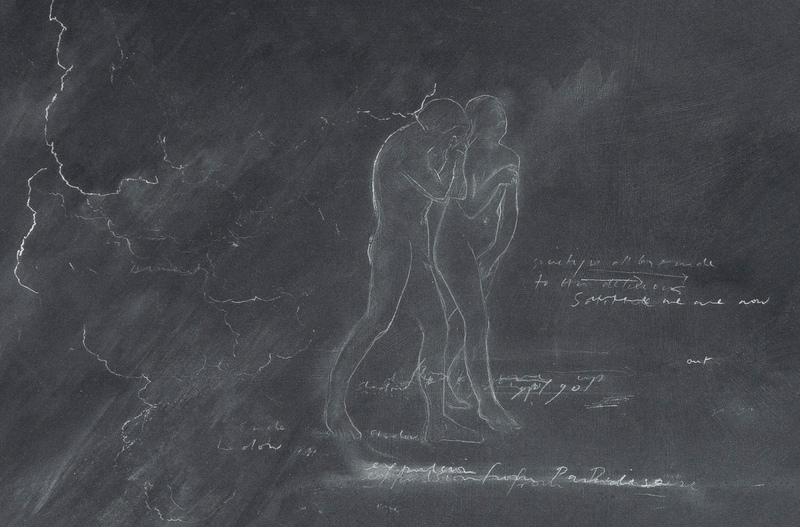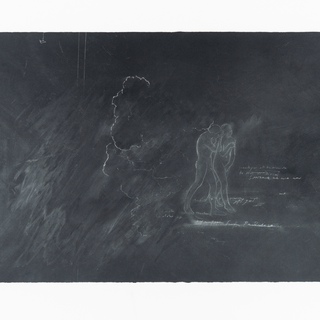About The Work
In Expulsion from Paradise the silhouettes of two bodies in a motion of despair appear in a skyscape on a black, chalk-dusty background. The isolated souls are drawn from an early renaissance fresco by Masaccio, that has lingered in the artist’s mind ever since the first time she discovered it:
I saw Masaccio’s Expulsion from the Garden of Eden when I was seventeen. It was to be my first encounter with art discovered originally in a book. I had gone on a pilgrimage to Italy to look for it and even won a small stipend with a friend from the school to travel there but then she was not allowed to board the train at the last minute (as she needed a transit visa to pass through Switzerland) and suddenly I was arriving in Florence alone and terrified. Still, on my first day, I sought out the Brancacci Chapel in Santa Maria del Carmine only to find the Chapel under renovation, full of scaffolding and the fresco obscured. Ducking beneath the blue tarpaulin, I could just about make out the figures of Adam and Eve, hunched over in anguish and shame. I realise, as I write this, they were already decontextualized to my view by the building works: cut out, emblematic and self-contained. I have drawn them often over the years, just their feet at first on my early blackboard drawings and then again recently when I was invited by a German magazine to depict a Briton living in Germany’s view on Brexit. In fact I had always known the fresco to be called ‘Expulsion from Paradise’. So given the turmoil and melancholy of the world and an empty surface on which to work, it is perhaps no surprise that they have appeared again in ever-greater isolation.—Tacita Dean
The delicate intimacy of Expulsion from Paradise materializes the continuous unfolding of time by revealing traces of the artist’s hand: the drawn lines, the erasures, and the handwriting. The iconic figures of Adam and Eve have been influencing Dean’s work ever since the first time she saw Masaccio’s fresco but have not appeared in their entirety up until now. For the anniversary print, Dean initially worked with chalk on blackboard. Subsequently, all traces have been transferred to a photogravure plate. Then, the plate has been inked with a specific cold black, enabling exposure of the highlights while at the same time revealing the subtle layers of the blackboard’s entire surface.
About Tacita Dean
From The Magazine
- Interviews & Features: IFPDA Print Fair Preview - An Interview with BORCH Editions
- Interviews & Features: Q&A: Being Lost at Sea and Finding Spiral Jetty with Tacita Dean—The Artist Taking Over London
- Art 101: I Can't Believe It's Not A Photo! 7 Artists Using Photorealism in Drawing
- Art 101: Eleven New Art Books to Add to Your Summer Reading List
- Art 101: Accidental Listeners: Tacita Dean Explains Anri Sala
Photogravure on Hahnemühle Bütten 300 gsm
15.94 x 30.91 in
40.5 x 78.5 cm
The work is signed and numbered by the artist on verso.
About The Work
In Expulsion from Paradise the silhouettes of two bodies in a motion of despair appear in a skyscape on a black, chalk-dusty background. The isolated souls are drawn from an early renaissance fresco by Masaccio, that has lingered in the artist’s mind ever since the first time she discovered it:
I saw Masaccio’s Expulsion from the Garden of Eden when I was seventeen. It was to be my first encounter with art discovered originally in a book. I had gone on a pilgrimage to Italy to look for it and even won a small stipend with a friend from the school to travel there but then she was not allowed to board the train at the last minute (as she needed a transit visa to pass through Switzerland) and suddenly I was arriving in Florence alone and terrified. Still, on my first day, I sought out the Brancacci Chapel in Santa Maria del Carmine only to find the Chapel under renovation, full of scaffolding and the fresco obscured. Ducking beneath the blue tarpaulin, I could just about make out the figures of Adam and Eve, hunched over in anguish and shame. I realise, as I write this, they were already decontextualized to my view by the building works: cut out, emblematic and self-contained. I have drawn them often over the years, just their feet at first on my early blackboard drawings and then again recently when I was invited by a German magazine to depict a Briton living in Germany’s view on Brexit. In fact I had always known the fresco to be called ‘Expulsion from Paradise’. So given the turmoil and melancholy of the world and an empty surface on which to work, it is perhaps no surprise that they have appeared again in ever-greater isolation.—Tacita Dean
The delicate intimacy of Expulsion from Paradise materializes the continuous unfolding of time by revealing traces of the artist’s hand: the drawn lines, the erasures, and the handwriting. The iconic figures of Adam and Eve have been influencing Dean’s work ever since the first time she saw Masaccio’s fresco but have not appeared in their entirety up until now. For the anniversary print, Dean initially worked with chalk on blackboard. Subsequently, all traces have been transferred to a photogravure plate. Then, the plate has been inked with a specific cold black, enabling exposure of the highlights while at the same time revealing the subtle layers of the blackboard’s entire surface.
About Tacita Dean
From The Magazine
- Interviews & Features: IFPDA Print Fair Preview - An Interview with BORCH Editions
- Interviews & Features: Q&A: Being Lost at Sea and Finding Spiral Jetty with Tacita Dean—The Artist Taking Over London
- Art 101: I Can't Believe It's Not A Photo! 7 Artists Using Photorealism in Drawing
- Art 101: Eleven New Art Books to Add to Your Summer Reading List
- Art 101: Accidental Listeners: Tacita Dean Explains Anri Sala
Published by BORCH Editions
- Ships in 10 to 14 business days from Denmark.
- This work is final sale and not eligible for return.
- Questions about this work?
- Interested in other works by this artist or other artists? We will source them for you.
- Want to pay in installments?
Contact an Artspace Advisor
advisor@artspace.com
























